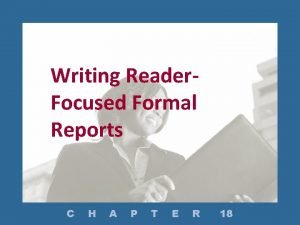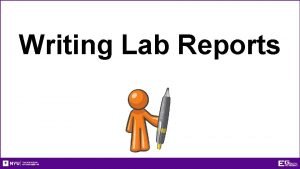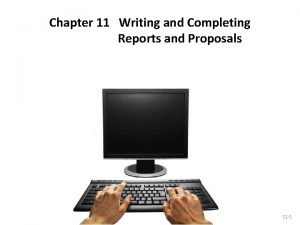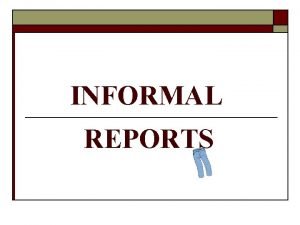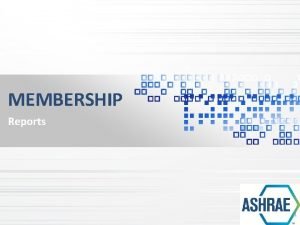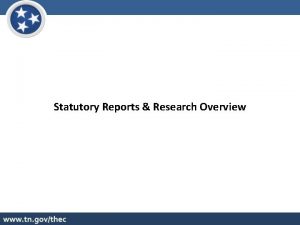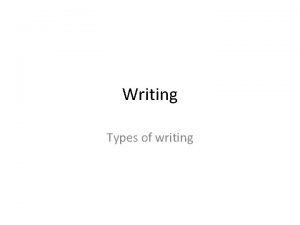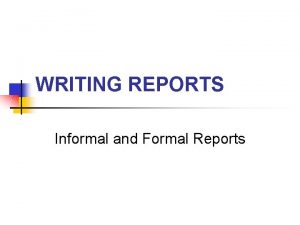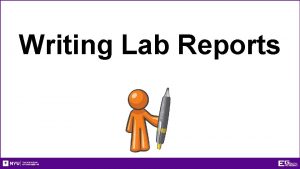Research reports Research writing Types of research reports










- Slides: 10

Research reports

Research writing • Types of research reports – Academic research reports – Business research reports

Basis Academic research (thesis) Business research (project report) Stimulus Research gap identified by survey of literature Purpose To extend the horizons of To provide information knowledge( basic research). base for decision making To find new applications (applied research) Outcome Addition to knowledge. Recommendations for action. Directions for future research. Recommendations for future action Audience Examiners , researchers, policy makers and public Managers and policy makers A situation with a problem or opportunity

A research report • Research papers are organized so that the information flow resembles an hourglass in that it goes from general to specific and then back to general again. The introduction and literature review sections will introduce the problem and provide general information. The methods and results will provide specific, detailed information about this research project and the discussion/conclusion will discuss the findings in a larger context. Broadly a research report has: • • Prefatory parts Text Supplementary parts Appended parts


• • Title The title should be specific and indicate the problem the research project addresses using keywords that will be helpful in literature reviews in the future. • • Abstract The abstract is used by readers to quickly review the overall content of the paper. Journals typically place strict word limits on abstracts, such as 200 words, making them a challenge to write. The abstract should provide a complete synopsis of the research paper and should introduce the topic and the specific research question, provide a statement regarding methodology and should provide a general statement about the results and the findings. Because it is really a summary of the entire research paper, it is often written last. • • Introduction The introduction begins by introducing the broad overall topic and providing basic background information. It then narrows down to the specific research question relating to this topic. It provides the purpose and focus for the rest of the paper and sets up the justification for the research. •

• • Literature Review The purpose of the literature review is to describe past important research and relate it specifically to the research problem. It should be a synthesis of the previous literature and the new idea being researched. The review should examine the major theories related to the topic to date and their contributors. It should include all relevant findings from credible sources, such as academic books and peer-reviewed journal articles. • • Methodology The methods section will describe the research design and methodology used to complete the study. The general rule of thumb is that readers should be provided with enough detail to replicate the study. • • Results In this section, the results of the analysis are presented. How the results are presented will depend upon whether the research study was quantitative or qualitative in nature. This section should focus only on results that are directly related to the research or the problem. Graphs and tables should only be used when there is too much data to efficiently include it within the text. This section should present the results, but not discuss their significance.

• Discussion/Conclusion • This section should be a discussion of the results and the implications on the field, as well as other fields. The hypothesis should be answered and validated by the interpretation of the results. This section should also discuss how the results relate to previous research mentioned in the literature review, any cautions about the findings, and potential for future research. • References/Bibliography • The research paper is not complete without the list of references. This section should be an alphabetized list of all the academic sources of information utilized in the paper. The format of the references will match the format and style used in the paper. Common formats include APA, MLA, Harvard and so forth.


Characteristics of a good report • • • Factual Comprehensive Objective Logical Consistent Concise Clear Reader oriented Creative
 How do informational reports and analytical reports differ
How do informational reports and analytical reports differ Purpose of writing reports
Purpose of writing reports Writing and completing reports and proposals
Writing and completing reports and proposals Reports and proposals
Reports and proposals Short report writing pdf
Short report writing pdf Maintain records and reports
Maintain records and reports Types of business reports
Types of business reports What is ad hoc reporting in accounting
What is ad hoc reporting in accounting Adm full form in accenture
Adm full form in accenture Accenture delivery tools for reporting purpose
Accenture delivery tools for reporting purpose Examples of informal report
Examples of informal report
